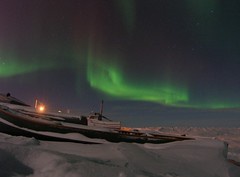
When I first saw the journal question “What color is the sky” I immediately thought that this was a tricky question because the sky has no defined color. However, when we shared our journal entries with the rest of the class, I realized that even if I have always believed the sky has no color because it is empty, it is in reality more intricate to describe its color. As if it has different moods, the sky changes of color throughout the day. It is hard to believe that something so huge, that has no material in it apart from molecules, can have such complex colors. It can even be several colors at the same time as seen in the Northern Lights. It has always fascinated me that in the night you could be able to see such bright colors in the sky.
To explore a first idea on how these lights appear, I found in the Corpuscular Theory of The Aurora by Carl Stormer an early explanation: “Arrhenius, in 1900, published his hypothesis that the Sun continually sends forth small electrified particles, varying in size from one ten-thousandth to one thousandth of a millimeter in diameter, and that these particles are repelled from the Sun by the pressure of light, and that on reaching the Earth’s atmosphere cause aurora.”(Stormer, 2012) Here we have more of an explanation on how the solar light penetrates the atmosphere in order for us to be able to receive the lights waves.
I then researched for a more recent explanation of the origin of Northern Lights. Five researchers made an experiment called “Simulating the aurora borealis” using an algorithm to simulate the aurora borealis. They used the same concept as Arrhenius introduced in 1900, high energy electrons that come from the Sun enter the Earth’s atmosphere. However, they then gave a more detailed explanation of the whole process. The electrons coming from the Sun enter the atmosphere in narrow regions centered on the magnetic poles. The excited electrons collide with atmospheric atoms which are excited at higher energy levels. When the excited atoms return to low levels of energy, they emit rapidly varying visible light in a curtain-like volume which creates the Aurora. By simulating these light emissions, the scientists were able to render the major visual aspects of auroral display. All of the above information is paraphrased from the work of G.V.G Baranoski, J.G. Rokne, P. Shirley, T. Trondsen, R. Bastos.
Unfortunately, we are not able to see these enlightened nights all over the globe. But everywhere on earth we are able to see changes in the color of the sky with the sunrise and the sunset. We see these different colors at these precise moments of the day due to the angle at which the Sun is. The longer wavelengths are able to make it through the atmosphere and come to our eye. Which is why we see reddish tones in the sunsets and sunrises.
Bibliography
Simulating the aurora borealis – IEEE Conference Publication. [accessed 2020 Mar 5]. https://ieeexplore.ieee.org/abstract/document/883852
Störmer C. Corpuscular theory of the aurora borealis. AGU Journals. 2012 Dec 7 [accessed 2020 Mar 5]. https://agupubs.onlinelibrary.wiley.com/doi/epdf/10.1029/TE022i001p00023
This post was super interesting to me, especially because seeing the Northern Lights in Iceland is at the top of my bucketlist! When I saw the title of your post, I knew I had to read and learn more about it. I didn’t know that the borealis was caused by electrons released from the sun. I had always though it was due to the way the particles bounce light off them. From your article, I guess it would make sense that you can only see the Northern Lights in countries like Iceland due to the magnetic poles. I appreciated how you were able to explain the experiment in simpler terms as well. It really helped me to understand and appreciate the Northern Lights more!
I’ve always wanted to see the northern lights! I really appreciated the comparison made in the beginning of the sky and the ways the colors change, to the way moods fluctuate. I’ve never thought of it this way, and bringing about this comparison is an interested perspective. Also, I found Stormers explanation for the northern lights particularly interesting. I would’ve never thought the northern lights could come be small electrified particles that are coming from the sun, since they appear at nighttime. It was also fascinating to learn that the visible light in the northern lights is emitted by atoms that are actually calm, because I would’ve expected the light to come from excited atoms that are bouncing on each other.
The Northern Lights have always been something I’ve wanted to witness firsthand because they are so gorgeous! While reading your post I noticed lots of similarities to a topic in my Chemistry class that was about the emission of photons. It is the same exact principle where electrons at high energies emit light when they jump down energy levels but at a much larger scale. It is very interesting to hear about real life applications of the topics learned during some of your classes!